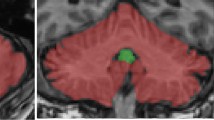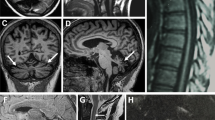Abstract
The pedunculopontine nucleus (PPN) is engaged in posture and gait control, and neuronal degeneration in the PPN has been associated with Parkinsonian disorders. Clinical outcomes of deep brain stimulation of the PPN in idiopathic Parkinson’s disease (IPD) and progressive supranuclear palsy (PSP) differ, and we investigated whether the PPN is differentially affected in these conditions. We had the rare opportunity to record continuous electrophysiological data intraoperatively in 30 s blocks from single microelectrode contacts implanted in the PPN in six PSP patients and three IPD patients during rest, passive movement, and active movement. Neuronal spikes were sorted according to shape using a wavelet-based clustering approach to enable comparisons between individual neuronal firing rates in the two disease states. The action potential widths showed a bimodal distribution consistent with previous findings, suggesting spikes from noncholinergic (likely glutamatergic) and cholinergic neurons. A higher PPN spiking rate of narrow action potentials was observed in the PSP than in the IPD patients when pooled across all three conditions (Wilcoxon rank sum test: p = 0.0141). No correlation was found between firing rate and disease severity or duration. The firing rates were higher during passive movement than rest and active movement in both groups, but the differences between conditions were not significant. PSP and IPD are believed to represent distinct disease processes, and our findings that the neuronal firing rates differ according to disease state support the proposal that pathological processes directly involving the PPN may be more pronounced in PSP than IPD.




Similar content being viewed by others
References
Mori F, Okada K, Nomura T, Kobayashi Y (2016) The pedunculopontine tegmental nucleus as a motor and cognitive interface between the cerebellum and basal ganglia. Front Neuroanat 10:1–8. https://doi.org/10.3389/fnana.2016.00109
Hirsch EC, Graybielt ANNM, Duyckaertst C, Javoy-agid F (1987) Neuronal loss in the pedunculopontine tegmental nucleus in Parkinson disease and in progressive supranuclear palsy. Proc Natl Acad Sci USA 84:5976–5980
Jellinger K (1988) The pedunculopontine nucleus in Parkinson’s disease, progressive supranuclear palsy and Alzheimer’s disease. J Neurol Neurosurg Psychiatry 51:540–543
Pahapill PA, Lozano AM (2000) The pedunculopontine nucleus and Parkinson’s disease. Brain 123:1767–1783
Zrinzo L, Zrinzo L, Hariz M (2007) The peripeduncular nucleus: a novel target for deep brain stimulation? NeuroReport 8:1631–1633
Weinberger M, Hamani C, Hutchison WD et al (2008) Pedunculopontine nucleus microelectrode recordings in movement disorder patients. Exp Brain Res 188:165–174. https://doi.org/10.1007/s00221-008-1349-1
Pötter-Nerger M, Volkmann J (2013) Deep brain stimulation for gait and postural symptoms in Parkinson’s disease. Mov Disord 28:1609–1615. https://doi.org/10.1002/mds.25677
Morita H, Hass CJ, Moro E et al (2014) Pedunculopontine nucleus stimulation: where are we now and what needs to be done to move the field forward? Front Neurol. https://doi.org/10.3389/fneur.2014.00243
Thevathasan W, Cole MH, Graepel CL et al (2012) A spatiotemporal analysis of gait freezing and the impact of pedunculopontine nucleus stimulation. Brain 135:1446–1454. https://doi.org/10.1093/brain/aws039
Mazzone P, Lozano A, Stanzione P et al (2005) Implantation of human pedunculopontine nucleus: a safe and clinically relevant target in Parkinson’s disease. NeuroReport 16:1877–1881. https://doi.org/10.1097/01.wnr.0000187629.38010.12
Moro E, Hamani C, Poon YY et al (2010) Unilateral pedunculopontine stimulation improves falls in Parkinson’s disease. Brain 133:215–224. https://doi.org/10.1093/brain/awp261
Scelzo E, Lozano AM, Hamani C et al (2017) Peduncolopontine nucleus stimulation in progressive supranuclear palsy: a randomised trial. J Neurol Neurosurg Psychiatry 88:613–616. https://doi.org/10.1136/jnnp-2016-315192
Galazky I, Kaufmann J, Lorenzl S et al (2018) Deep brain stimulation of the pedunculopontine nucleus for treatment of gait and balance disorder in progressive supranuclear palsy: effects of frequency modulations and clinical outcome. Park Relat Disord 50:81–86. https://doi.org/10.1016/j.parkreldis.2018.02.027
Matsumura M (2005) The pedunculopontine tegmental nucleus and experimental parkinsonism. J Neurol 252:5–12. https://doi.org/10.1007/s00415-005-4003-x
Litvan I, Agid Y, Jankovic J et al (1996) Accuracy of clinical criteria for the diagnosis of progressive supranuclear palsy (Steele–Richardson–Olszewski syndrome). Neurology 46:922–930
Hughes A, Daniel S, Kilford L, Lees A (1992) Accuracy of clinical diagnosis of idiopathic Parkinson’s disease: a clinico-pathological study of 100 cases. J Neurol Neurosurg Psychiatry 55:181–184
Movement Disorder Society Task Force on Rating Scales for Parkinson’s Disease (2003) The Unified Parkinson’s Disease Rating Scale (UPDRS): status and recommendations. Mov Disord 18(7):738–750
Hutchison WD, Allan RJ, Opitz H et al (1998) Neurophysiological identification of the subthalamic nucleus in surgery for Parkinson’s disease. Ann Neurol 44:622–628
Quiroga RQ, Nadasdy Z, Ben-Shaul Y (2004) Unsupervised spike detection and sorting with wavelets and superparamagnetic clustering. Neural Comput 16:1661–1687
Matsumura M, Watanabe K, Ohye C (1997) Single-unit activity in the primate nucleus tegmenti pedunculopontinus related to voluntary arm movement. Neurosci Res 28:155–165
Takakusaki K, Shiroyama T, Kitai ST (1997) Two types of cholinergic neurons in the rat tegmental pedunculopontine nucleus: electrophysiological and morphological characterization. Neuroscience 79:1089–1109
De Winter JCF (2013) Using the Student’s t-test with extremely small sample sizes. Pract Assess Res Eval 10:1-12
Warmuth-Metz M, Naumann M, Csoti I, Solymosi L (2001) Measurement of the midbrain diameter on routine magnetic resonance imaging: a simple and accurate method of differentiating between Parkinson disease and progressive supranuclear palsy. Arch Neurol 58:1076–1079
Shao N, Yang J, Li J, Shang H-F (2014) Voxelwise meta-analysis of gray matter anomalies in progressive supranuclear palsy and Parkinson's disease using anatomic likelihood estimation. Front Hum Neurosci 8:1–10
Egerton T, Williams DR, Iansek R (2012) Comparison of gait in progressive supranuclear palsy, Parkinson’s disease and healthy older adults. BMC Neurol 12:1–6. https://doi.org/10.1186/1471-2377-12-116
Dormont J, Conde H, Farin D (1998) The role of the pedunculopontine tegmental nucleus in relation to conditioned motor performance in the cat. I. Context-dependent and reinforcement-related single unit activity. Exp Brain Res 121:401–410
Scarnati E, Proia A, Di Loreto S, Pacitti C (1987) The reciprocal electrophysiological influence between the nucleus tegmenti pedunculopontinus and the substantia nigra in normal and decorticated rats. Brain Res 423:116–124
Futami T, Takakusaki K, Kitai ST (1995) Glutamatergic and cholinergic inputs from the pedunculopontine tegmental nucleus to dopamine neurons in the substantia nigra pars compacta. Neurosci Res 21:331–342
Charara ALI, Smith Y, Parent A (1996) Glutamatergic inputs from the pedunculopontine nucleus to midbrain dopaminergic neurons in primates: Phaseolus vulgaris-leucoagglutinin anterograde labeling combined with postembedding glutamate and GABA immunohistochemistry. J Comp Neurol 266:254–266
Galtieri DJ, Estep CM, Wokosin DL et al (2017) Pedunculopontine glutamatergic neurons control spike patterning in substantia nigra dopaminergic neurons. eLife 6:e30352
Bevan M, Bolam JP (1995) Cholinergic, GABAergic, and glutamate-enriched inputs from the mesopontine tegmentum to the subthalamic nucleus in the rat. J Neurosci 15:7105–7120
Massey LA, Jäger HR, Paviour DC et al (2013) The midbrain to pons ratio A simple and specific MRI sign of progressive supranuclear palsy. Neurology 80:1856–1861
Jeon M, Ha Y, Cho Y et al (2003) Effect of ipsilateral subthalamic nucleus lesioning in a rat parkinsonian model: study of behavior correlated with neuronal activity in the pedunculopontine nucleus. J Neurosurg 99:762–767
Breit S, Bouali-Benazzouz R, Benabid A, Benazzouz A (2001) Unilateral lesion of the nigrostriatal pathway induces an increase of neuronal activity of the pedunculopontine nucleus, which is reversed by the lesion of the subthalamic nucleus in the rat. Eur J Neurosci 14:1833–1842
Hardman CD, Halliday GM, McRitchie DA et al (1997) Progressive supranuclear palsy affects both the substantia nigra pars compacta and reticulata. Exp Neurol 144:183–192. https://doi.org/10.1006/exnr.1997.6415
Fling BW, Cohen RG, Mancini M et al (2013) Asymmetric pedunculopontine network connectivity in parkinsonian patients with freezing of gait. Brain 136:2405–2418. https://doi.org/10.1093/brain/awt172
Fraix V, Bastin J, David O et al (2013) Pedunculopontine nucleus area oscillations during stance, stepping and freezing in Parkinson’s disease. PLoS ONE. https://doi.org/10.1371/journal.pone.0083919
Funding
None.
Author information
Authors and Affiliations
Contributions
IG: conceived of and designed the study and recorded the electrophysiological data; JV: surgically implanted the electrodes; IG, JK, and JV: localized the electrodes using imaging; CMSR: designed and performed the electrophysiological data analysis; IG and CMSR interpreted the data analysis, drafted the manuscript, and revised it critically; JK, JV, HH, and HJH: critically revised the manuscript. All the authors approved the final version of the manuscript.
Corresponding author
Ethics declarations
Conflicts of interest
The authors declare that they have no conflict of interest.
Ethical standards
The study was approved by the Local Ethics Committee of the Otto-von-Guericke University, Magdeburg, Germany and was performed in accordance with the ethical standards laid down in the 1964 Declaration of Helsinki and its later amendments. All participants gave their informed written consent prior to their inclusion in the study.
Rights and permissions
About this article
Cite this article
Galazky, I., Kaufmann, J., Voges, J. et al. Neuronal spiking in the pedunculopontine nucleus in progressive supranuclear palsy and in idiopathic Parkinson’s disease. J Neurol 266, 2244–2251 (2019). https://doi.org/10.1007/s00415-019-09396-9
Received:
Revised:
Accepted:
Published:
Issue Date:
DOI: https://doi.org/10.1007/s00415-019-09396-9




